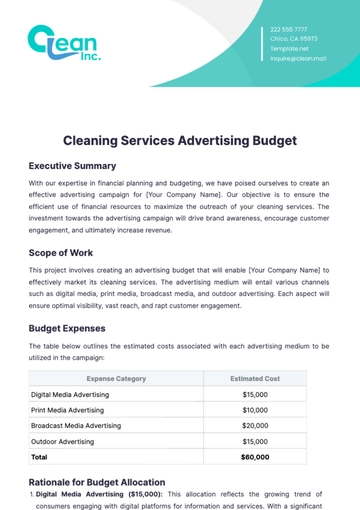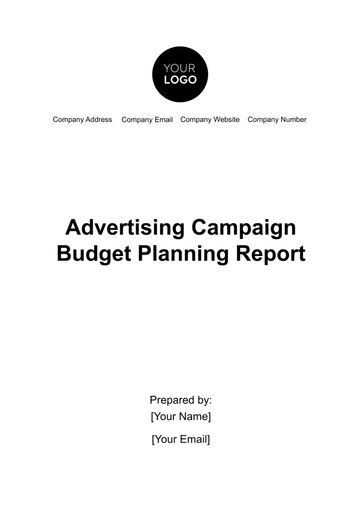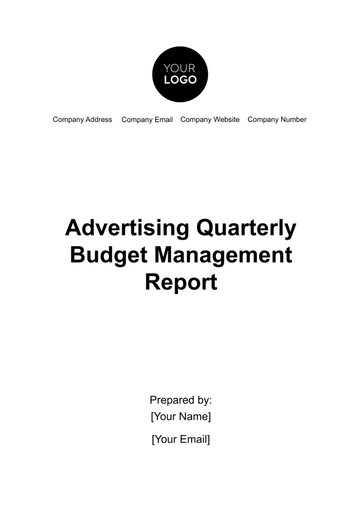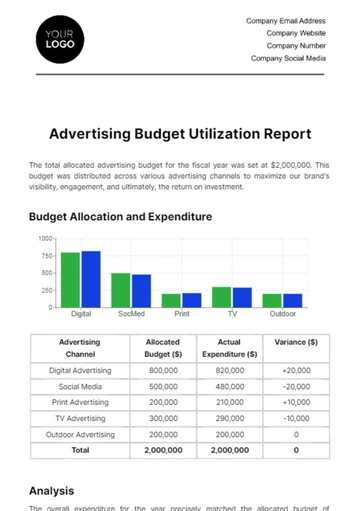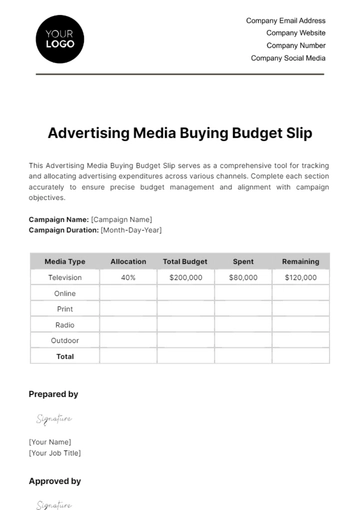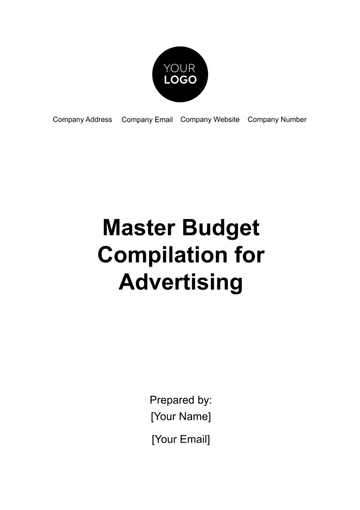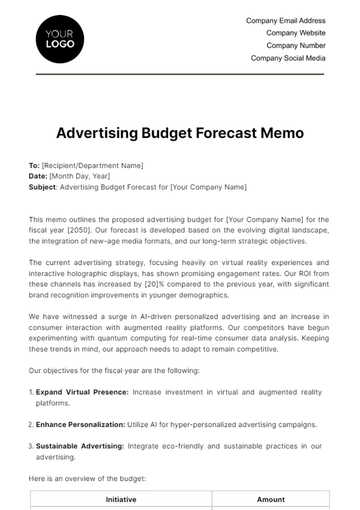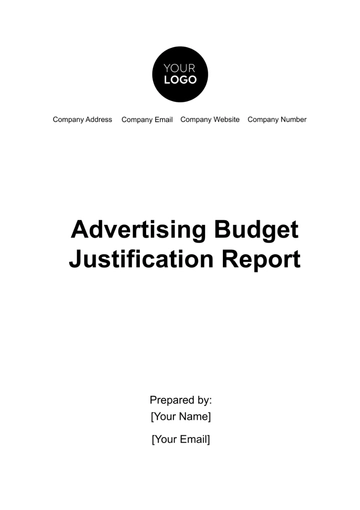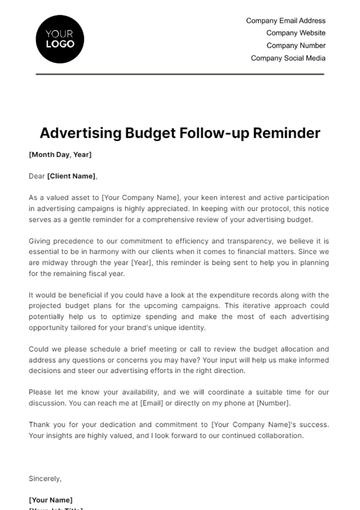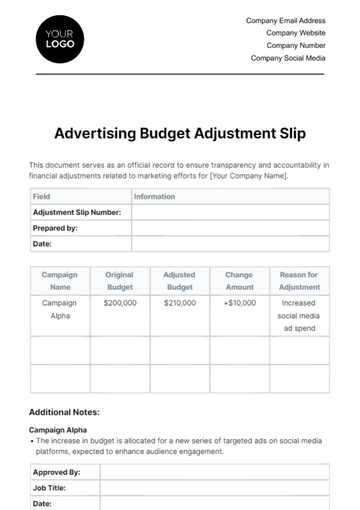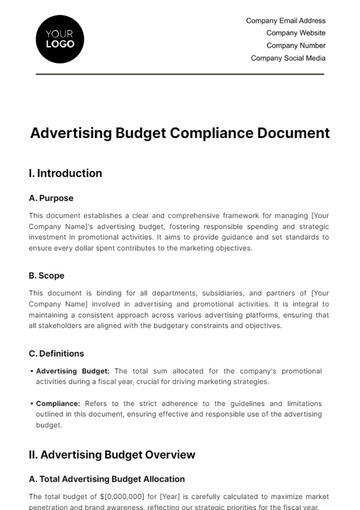Free Internal Audit Report for Advertising Budgets
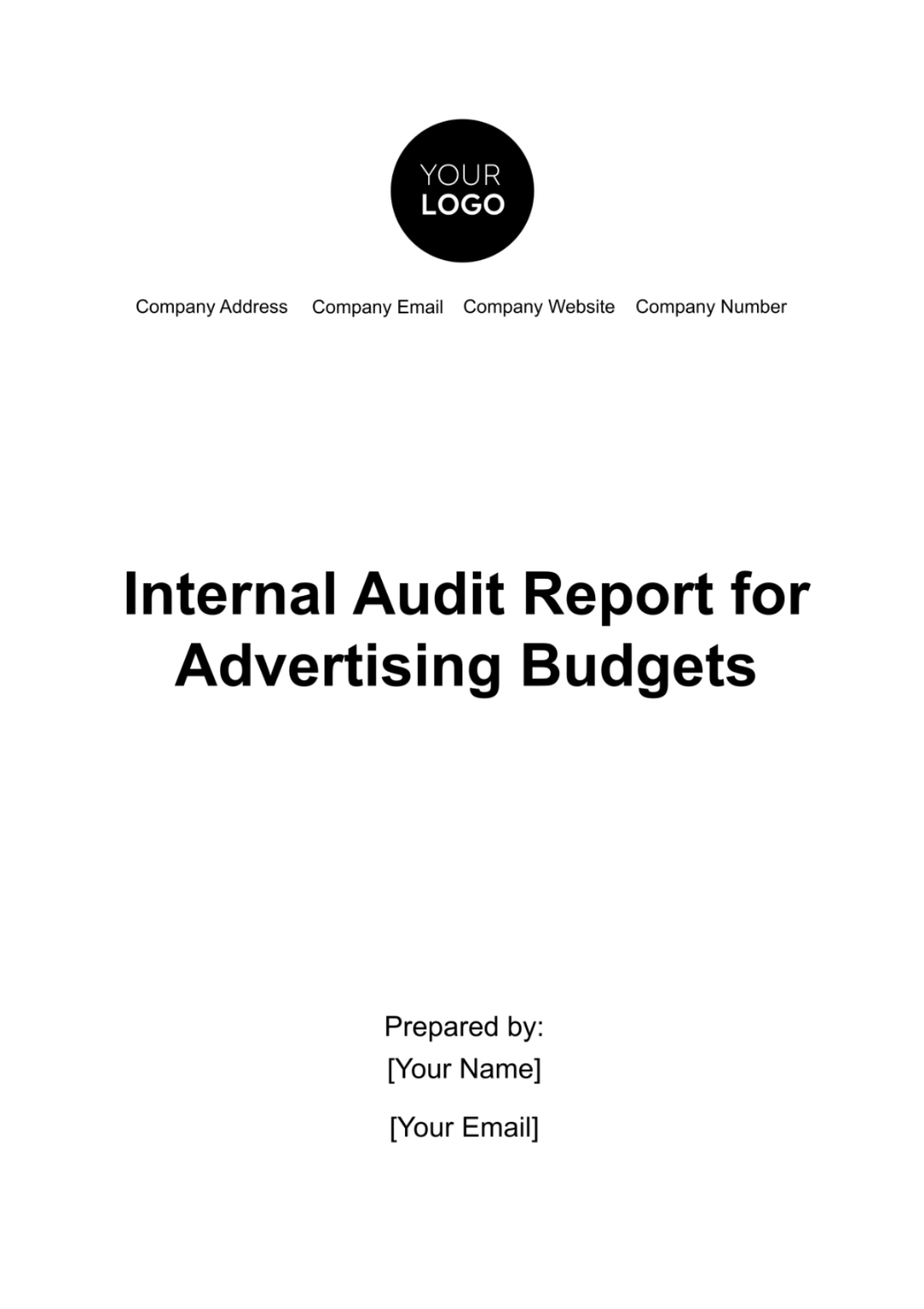
I. Executive Summary
This Internal Audit Report presents a detailed analysis of the advertising budgets managed by [Your Company Name] for the fiscal year 2050. Our objective was to critically evaluate the effectiveness, efficiency, and compliance of budget utilization across our diverse range of advertising campaigns. This examination was conducted to identify both the strong points and potential areas for improvement in our financial management strategies related to advertising.
Our audit process thoroughly reviewed budget allocation, actual expenditure, return on investment (ROI), and adherence to internal policies and industry standards. The report provides insights into how budget variances affected campaign performance and highlights the correlation between budget planning and campaign success. Particular attention was paid to campaigns that either significantly overperformed or underperformed regarding ROI, leading to a deeper understanding of the factors contributing to these outcomes.
The findings reveal that while most campaigns demonstrated a commendable level of efficiency and compliance, there are notable discrepancies in budget management and ROI achievements. These insights form the basis for our recommendations, which focus on enhancing budget forecasting accuracy, optimizing ROI across all campaigns, and maintaining high standards of compliance and ethical advertising practices.
Overall, this report is a critical tool for [Your Company Name] in refining our advertising strategies, ensuring more effective budget utilization, and maintaining our commitment to ethical and compliant advertising practices. The recommendations, if implemented, are expected to significantly bolster the overall performance and impact of our future advertising campaigns.
II. Audit Scope
The scope of this internal audit encompasses a comprehensive examination of several key areas crucial to the financial health and effectiveness of our advertising strategies at [Your Company Name]. These areas have been carefully chosen to ensure a holistic understanding of our advertising financial management. The detailed aspects of the audit scope include:
A. Evaluation of Budget Allocation and Utilization
Budget Planning and Allocation: Assessing the processes and criteria used for allocating budgets to various advertising campaigns. This includes an evaluation of how well the budgets were planned by the campaign goals and expected outcomes.
Actual Expenditure Analysis: Comparing the planned budget against the actual expenditure for each campaign. This involves identifying variances and understanding the reasons behind any over or under-spending.
Resource Allocation Efficiency: Reviewing the efficiency of resource allocation, ensuring that the budget was utilized in a manner that maximized campaign impact and aligned with strategic objectives.
B. Analysis of Cost Efficiency and Return on Investment (ROI)
Cost Efficiency Evaluation: Analyzing the cost-effectiveness of the campaigns by examining the relationship between the expenditure and the results achieved, focusing on metrics such as cost per acquisition (CPA) and cost per impression (CPI).
ROI Calculation and Assessment: Calculating the ROI for each campaign to measure its financial success. This includes an analysis of revenue generated against the total expenditure, providing insights into the profitability and effectiveness of our advertising investments.
Benchmarking Against Industry Standards: Comparing our campaign ROIs with industry standards and best practices to gauge our competitive standing and identify areas for improvement.
C. Compliance with Company Policies and Industry Standards
Adherence to Internal Policies: Ensuring that all campaigns align with [Your Company Name]'s internal policies, including financial management, ethical advertising, and risk management guidelines.
Regulatory Compliance: Verifying compliance with relevant advertising standards and regulations at both the national and international levels. This is crucial in maintaining our reputation and avoiding legal complications.
Data Protection and Privacy: Reviewing the adherence to data protection laws and privacy standards, especially in digital advertising campaigns that utilize customer data.
By thoroughly exploring these areas, the audit aims to provide a comprehensive view of the advertising financial management at [Your Company Name], identifying strengths, uncovering potential risks, and recommending measures for improvement. This approach is designed to bolster the efficiency, effectiveness, and compliance of our advertising campaigns, aligning them more closely with our corporate objectives and ethical standards.
III. Methodology
The methodology employed in conducting this internal audit was meticulously designed to provide a comprehensive and accurate analysis of the advertising budgets at [Your Company Name]. Our approach combined quantitative data review with qualitative insights, ensuring a well-rounded evaluation. The key components of our methodology included:
A. Review of Financial Documents and Budgets
Time Frame: We conducted a thorough examination of all financial records and budget documents spanning from [January 2050] to [December 2050]. This period was selected to provide a complete view of the fiscal year's advertising financial activities.
Document Types: The review encompassed various types of financial documents, including initial budget proposals, approved budget plans, expenditure reports, and final financial statements.
Data Analysis: Special attention was given to discrepancies between planned and actual expenditures, as well as to the allocation efficiency across different advertising channels and campaigns.
B. Interviews with Key Personnel
Departments Involved: Interviews were conducted with key personnel from both the marketing and finance departments. These interviews aimed to gather insights on the decision-making processes, challenges faced, and strategies implemented during the fiscal year.
Structured and Open-Ended Questions: The interviews included structured and open-ended questions, allowing us to obtain both quantitative data and qualitative perspectives.
Anonymity and Confidentiality: To ensure candid and accurate responses, we maintained strict confidentiality and anonymity protocols throughout the interview process.
C. Comparative Analysis
Benchmarking Parameters: We compared our company’s advertising budget performance against industry benchmarks. These benchmarks included average ROI, CPA, and other relevant financial metrics in the advertising sector.
Best Practices: Our analysis also involved studying best practices in advertising budget management. This research helped identify potential areas for improvement and innovative strategies that could be adopted.
Adaptation to Our Context: While considering industry standards, we also ensured that the findings were relevant and adaptable to the specific context and goals of [Your Company Name].
Through this comprehensive methodology, our audit aimed to provide an objective and thorough analysis of the advertising budgets and financial management practices at [Your Company Name]. This approach enabled us to not only assess past performance but also to identify actionable insights for future improvements.
IV. Findings and Analysis
A. Budget Allocation and Utilization
The chart and table below present the budget allocation:
Campaign | Allocated Budget | Actual Expenditure | Variance |
[Campaign Name] | $500,000 | $480,000 | $20,000 under |
[Campaign Name]'s expenditure is lesser than its allocated budget by $20,000. This variance indicates stringent budget control of the required resources during the planning phase. This showcase that we have carried out rigorous initial budget planning, regular budget reviews during campaign execution, and stringent approval processes for additional expenditures.
B. Cost Efficiency and ROI
The following chart and table showcase the data:
Campaign | Total Expenditure | Revenue Generated | ROI |
[Campaign Name] | $480,000 | $700,000 | 46% |
Interestingly, [Campaign Name], achieved the highest ROI of 46%. This suggests that the funds were effectively utilized, leading to greater revenue generation. A thorough examination of this campaign’s strategies should be conducted to distill key elements that can be applied to other campaigns.
C. Compliance with Policies and Standards
Observations: The audit revealed that all campaigns adhered to the company’s ethical guidelines and industry regulations. This compliance is crucial in maintaining the integrity and reputation of [Your Company Name]. The adherence to these standards reflects well on the company’s commitment to ethical practices and legal obligations.
Recommendations: To maintain this standard of compliance, it is recommended to continue regular training sessions for staff on compliance and ethical advertising practices. These sessions should be updated regularly to reflect any changes in legal standards and industry best practices. Additionally, implementing routine compliance audits can ensure ongoing adherence and provide early detection of potential deviations from established policies and standards.
V. Action Plan
A. Develop a More Accurate Budget Forecasting Model
The necessity for a more precise budget forecasting model is evident from the audit findings. The current model at [Your Company Name] has led to significant variances between allocated budgets and actual expenditures. To rectify this, we propose developing a forecasting model that leverages historical data, current market trends, and advanced predictive analytics. This new model will not only account for the usual advertising costs but also factor in potential market fluctuations and unforeseen expenses. Integrating machine learning algorithms can further enhance the accuracy of predictions by continuously learning from past budgeting outcomes. Implementing this advanced forecasting model will enable us to set more realistic budgets, reduce the risk of overspending, and allocate resources more efficiently.
B. Conduct Quarterly Reviews of Campaign Performance
Regular performance reviews are essential to ensure that our advertising campaigns are on track to meet their objectives. The audit has highlighted the need for more frequent and thorough evaluations. To this end, we will institute quarterly reviews of each campaign's performance. These reviews will assess various metrics such as reach, engagement, conversion rates, and ROI. They will involve cross-departmental teams, including marketing, finance, and analytics, to provide a holistic view of each campaign’s performance. These regular reviews will not only help in identifying underperforming campaigns early but also provide timely insights that can be used to tweak and optimize ongoing campaigns. This proactive approach will ensure that our advertising efforts align continuously with our strategic goals and market dynamics.
C. Implement ROI Improvement Strategies
Addressing the lower-than-desired ROI in campaigns, requires a targeted approach. We plan to implement specific ROI improvement strategies for these underperforming campaigns. This will involve a deep dive analysis to understand the underlying reasons for the low ROI, which could range from targeting the wrong audience to ineffective messaging or choice of advertising channels. Based on this analysis, we will redesign the campaign strategies, possibly reallocating the budget to more effective channels, refining the target audience, or overhauling the creative elements of the campaign. Additionally, investing in training for the marketing team on the latest advertising trends and technologies could provide new perspectives and approaches to enhance campaign performance. These tailored strategies aim to not only improve the ROI of individual campaigns but also contribute to the overall efficiency and effectiveness of [Your Company Name]'s advertising efforts.
VI. Conclusion
While the audit presents [Your Company Name] in a generally positive light regarding advertising campaign management, it also brings to the forefront specific areas that require attention and improvement. Addressing these issues with targeted actions will not only enhance the efficiency of budget utilization but also optimize the returns on investment, thus ensuring the continued success and growth of [Your Company Name]'s advertising endeavors. Moving forward, it will be crucial to apply the insights gained from this audit to refine our advertising strategies and maintain our commitment to excellence and compliance.
- 100% Customizable, free editor
- Access 1 Million+ Templates, photo’s & graphics
- Download or share as a template
- Click and replace photos, graphics, text, backgrounds
- Resize, crop, AI write & more
- Access advanced editor
Generate an internal audit report of your advertising budgets with our Internal Audit Report for Advertising Budgets Template! This customizable report from Template.net is editable, allowing you to create a detailed audit report. The AI Editor Tool simplifies the process, helping you ensure you tailor the report to your needs!
You may also like
- Budget Sheet
- Personal Budget
- Non Profit Budget
- Monthly Budget
- Project Budget
- HR Budget
- Company Budget
- Home Budget
- Weekly Budget
- College Budget
- Business Budget
- Construction Budget
- Small Business Budget
- Hotel Budget
- Annual Budget
- Home Renovation Budget
- Household Budget
- Student Budget
- Grocery Budget
- Marketing Budget
- Corporate Budget
- Startup Budget
- Manufacturing Budget
- Church Budget
- University Budget
- Annual Budget Plan
- Event Budget
- Operating Budget
- Travel Budget
- Food Budget
- IT and Software Budget
- School Budget
- Real Estate Budget
- Sales Budget
- Conference Budget
- Budget Finance
- Freelancer Budget
- Budget Advertising
